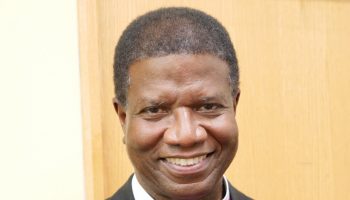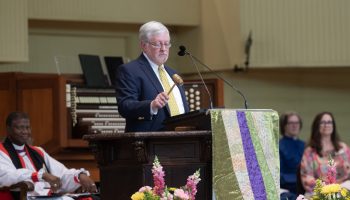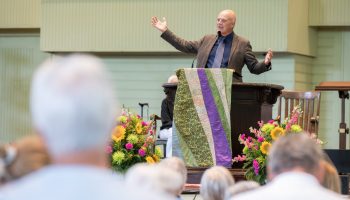
“I greet you with peace and the gift of great kindness that comes from our Father the Great Spirit and from our Honored Chief, Creator Sets Free (Jesus) the Chosen One,” said the Rev. Suzanne Wenonah Duchesne. She was reading from the book of Philemon 1:3 from the First Nations Version of the New Testament.
Duchesne preached at the 9:15 a.m. Monday morning worship service in the Amphitheater. Her sermon title was “Fortifications and Family,” and the scripture reading was Philemon 1:3–17. In this letter, the apostle Paul does not condemn slavery; he is not seeking to free Onesimus, but to send him back to his master. “This is a difficult letter to read,” said Duchesne.
The history of colonization began with the church, she said, and it began before Columbus. In 1095, during the First Crusade, Pope Urban II was the first to describe the Europeans’ right to take land from Indigenous inhabitants. The concept of “terra nullius” (empty land) was central, suggesting that lands not inhabited by Christians were vacant and available for claiming, regardless of the presence of Indigenous peoples, who were considered to be without souls.
The idea of people without souls was extended to Muslims by Pope Innocent IV in 1240. In 1366, this dehumanization was extended to women in Florence, Italy. The interaction of the papacy with the kingdoms of Spain, Portugal and France created a narrative of conquest, said Duchesne.
“We blame this on the Roman Catholic Church, but this all happened before the Reformation, so we are all guilty. No one is in the clear,” she said. The church instituted the idea of perpetual slavery of infidels, and through Pope Alexander VI in 1493, the Doctrine of Discovery was issued.
There were some priests who spoke for the people being enslaved she said, who thought they should be protected, but the powerful nobles doubled down on forced slavery so they could hold on to the land and enslave the people. Even William Bradford of the Plymouth Colony did not regret the death of several Indigenous people killed near the settlement, but did regret “that they were not converted.”
Duchesne said there was little in St. Paul to recommend him as a reformer. “His record is confusing. At one point he tells slaves to obey their masters, and in another letter he says there is neither slave nor free.”
She continued, “What we know as chattel slavery does not apply to the first century. Slaves were the lowest economic class, and even though they were not slaves for life, they were not free. These texts (in Paul) set the stage for chattel slavery and the subjugation of Indigenous people.”
Paul engaged Philemon in this letter, asking him to release Onesimus so that the two of them could work together with Paul. “Paul was talking about co-leadership, a beloved relationship, that Philemon would see Onesimus as the ‘heart of my heart,’ ” Duchesne said. “For this time, it was radical to change society, for this humanization to occur. Paul is asking Philemon to choose to break the hierarchy.”
When Duchesne visited the Museum of Mississippi History, she was struck by two dioramas, one of a French settlement and one of a Chickasaw settlement. The French one was surrounded by a high, square palisade with places for guns at the corners. In the Chickasaw one, the family homes were surrounded by a corn crib, and there was a palisade in the center if needed. “Each reflected the cultural values of the two communities: fortification versus family,” she said.
Duchesne shared a story told by the Rev. Thom Fassett, a United Methodist minister and member of the Seneca nation about the encounter with the Rev. Jacob Cram and Red Jacket. In 1805, Cram had come from the Boston Missionary Society to the Buffalo Creek Reservation to talk about a better way to worship God.
Cram talked for hours, and when he was done, Red Jacket had some questions and advice. He asked Cram why, if the white people had the same book and same religion, they had so many different denominations. “Why don’t you live in the same house?” Red Jacket asked. He suggested that Cram return when he chose to treat the Seneca people honestly.
“The colonizing attitude at Buffalo Creek showed the difference in values,” Duchesne said. “Cram valued fortifying the heart, speaking to a people who see each other as family, as beloved. We have to dig deeply into texts that have done harm, which scriptures have been an assault and which embody belovedness, the ones that value relationships.”
She said it takes courage and a willingness to engage in difficult conversations. “We have to be humble enough to allow ourselves to be confronted, to not run away when we are confronted (about our) colonizing behavior.”
The church kept this letter and there was a later bishop named Onesimus. Paul, in this letter, gave a hint of what beloved relationships look like. With Rome there was no negotiation, she said, “Paul wants to free (Philemon and Onesimus) from the culture, so they could lead and dream of a new way of being church.”
Duchesne continued, “How can a relationship like this move to kindness and caring, from (a relationship of) hardened hearts to (a relationship of) heart to heart? We each will find our own way, but we will not be alone, because we are a beloved family.”
The Rt. Rev. Eugene T. Sutton, senior pastor for Chautauqua, presided. The Rev. James Daprile read the scripture. The prelude was “Trio No. 7,” by Josef Rheinberger, played by Laura Smith, organ scholar, on the Massey Memorial Organ. The Motet Choir — under the direction of guest conductor James Bobb and accompanied by Owen Reyda, organ scholar, on the Massey — sang “Draw us in the Spirit’s Tether,” music by Harold Friedell and text by Percy Dearmer. Reyda played the postlude on the Massey organ. Support for this week’s chaplaincy and services is provided by the Mr. and Mrs. William Uhler Follansbee Memorial Chaplaincy.




